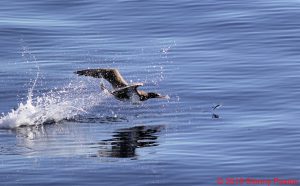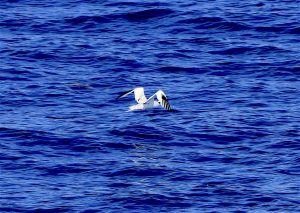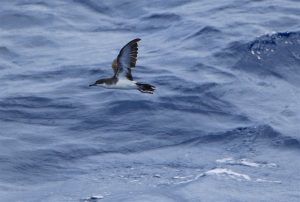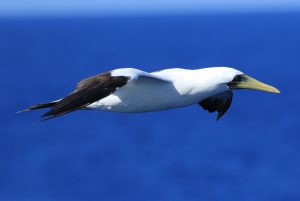 Back in early 2016, the Bureau of Ocean Energy Management (BOEM) reached out to the U.S. Fish and Wildlife Service (USFWS; seabirds), U.S. Geological Survey (USGS; sea turtles), and National Oceanic and Atmospheric Administration (NOAA; marine mammals) to discuss the feasibility of implementing a Gulfwide research and monitoring effort. BOEM’s Environmental Studies Program would provide the base funding for research to inform regulatory decision-making related to offshore energy development in the Outer Continental Shelf. In the Gulf of Mexico in particular, the primary impetus for this new research partnership, referred to as the Gulf of Mexico Marine Assessment Program for Protected Species, or GoMMAPPS, was related to offshore oil and gas development. Limited information is available regarding the species composition, distribution, and abundance of seabirds using the near- and offshore waters of the Gulf of Mexico, even though the level of oil and gas activity in this Region (in federal waters alone) exceeds all other BOEM Regions combined. Per the GoMMAPPS Seabird Science Plan and BOEM’s funding decision, we decided to implement broad-scale surveys using 2 survey platforms: USFWS Kodiak amphibious aircraft and NOAA Vessels of Opportunity. For brevity, we only include here a subset of Seabird Vessel Trip Reports along with a short preliminary data summary for seabird vessel surveys. We believe, however, that the GoMMAPPS aerial survey component warrants consideration for a future GoMAMN Newsletter. GoMMAPPS seabird data collection was initiated in the spring of 2017 (April-May) and will continue through 2019, with the potential of a winter aerial survey in early 2020, depending on availability of funding.
Back in early 2016, the Bureau of Ocean Energy Management (BOEM) reached out to the U.S. Fish and Wildlife Service (USFWS; seabirds), U.S. Geological Survey (USGS; sea turtles), and National Oceanic and Atmospheric Administration (NOAA; marine mammals) to discuss the feasibility of implementing a Gulfwide research and monitoring effort. BOEM’s Environmental Studies Program would provide the base funding for research to inform regulatory decision-making related to offshore energy development in the Outer Continental Shelf. In the Gulf of Mexico in particular, the primary impetus for this new research partnership, referred to as the Gulf of Mexico Marine Assessment Program for Protected Species, or GoMMAPPS, was related to offshore oil and gas development. Limited information is available regarding the species composition, distribution, and abundance of seabirds using the near- and offshore waters of the Gulf of Mexico, even though the level of oil and gas activity in this Region (in federal waters alone) exceeds all other BOEM Regions combined. Per the GoMMAPPS Seabird Science Plan and BOEM’s funding decision, we decided to implement broad-scale surveys using 2 survey platforms: USFWS Kodiak amphibious aircraft and NOAA Vessels of Opportunity. For brevity, we only include here a subset of Seabird Vessel Trip Reports along with a short preliminary data summary for seabird vessel surveys. We believe, however, that the GoMMAPPS aerial survey component warrants consideration for a future GoMAMN Newsletter. GoMMAPPS seabird data collection was initiated in the spring of 2017 (April-May) and will continue through 2019, with the potential of a winter aerial survey in early 2020, depending on availability of funding.

28 April–30 May 2017
Spring Plankton Survey
NOAA Vessel R/V Oregon II
From 28 April to 30 May 2017, three GoMMAPPS seabird observers accompanied the SEAMAP spring ichthyoplankton survey conducted aboard the R/V Oregon II based at the NOAA National Marine Fisheries Service, Pascagoula, MS. Nicholas Metheny (Leg 1) and J. Chris Haney and Michelle McDowell (Leg 2) stood watches to count all birds detected within a 300 m strip transect while the ship was underway between the standardized SEAMAP sampling stations. Observers counted for a total of ~180 hrs over 25 d which the ship was in transit. Approximately 4 d otherwise available and scheduled to be surveyed were lost due to weather and mechanical issues. Survey time per day ranged from ~2 hrs to just <14 hrs.
This initial launch of the GoMMAPPS seabird survey project was extraordinarily successful. In addition to widespread coverage across the Gulf of Mexico, especially the remote, deeper waters away from the continental shelf, observers detected no fewer than 25 species of pelagic, offshore, and coastal marine seabird species, as well as at least 7 species of cetaceans, two sea turtles, and various other biota. Seabird observers also detected several species for which their status has been heretofore poorly known.

17-30 September 2017
Fall Plankton Survey, Leg 2
NOAA Vessel R/V GORDON GUNTER
From 17–30 September 2017, two GoMMAPPS seabird observers accompanied the fall plankton cruise Leg 2 aboard the R/V Gordon Gunter based at the NOAA National Marine Fisheries Service, Pascagoula, MS. J. Chris Haney and Matt Love conducted counts of all birds detected within a 300 m strip transect while the ship was underway (Balance and Force 2016). Observers counted these and seabirds outside the strip transect for ~110 hrs over 13 d. No time that was scheduled to be surveyed was lost to weather conditions or to mechanical issues. Daily survey time ranged from ~4.0 to 12 hrs.
In general, spatial coverage from the R/V Gordon Gunter during this leg was widespread in the Central and Western Planning Areas over continental shelf habitats. Observers detected 20 different species of pelagic, offshore, and coastal marine birds, as well as a number of migrating passerines, shorebirds, raptors, and wading birds. The total count and the birds per day exceeded by a factor of three the encounter rates from any single GoMMAPPS survey conducted to date. By September 29, sightings of at least 7,860 individual birds were entered into the SEEBIRD database, for a detection rate of >600 birds/d or almost 70 birds/hr on Leg 2 of the NOAA 2017 fall plankton survey.

Winter Marine Mammal Cruise- Leg 3
8-22 January 2018
NOAA Vessel R/V GORDON GUNTER
From 12–27 February 2018, two GoMMAPPS seabird observers accompanied the GoMMAPPS winter marine mammal cruise Leg 3 aboard the R/V Gordon Gunter based out of the NOAA National Marine Fisheries Service lab, Pascagoula, MS. Jeff Gleason and Yvan Satge conducted counts of all birds detected within a 300-m strip transect while the ship was underway (Ballance and Force 2016). Observers counted seabirds for a total of ~15 hrs over 15 d. Essentially no time that was scheduled to be surveyed was lost to weather on this leg. Daily survey time ranged from ~11.0-11.5 hrs, with ~4.0 hrs of dedicated observation effort on the first afternoon while on transit from port (12 February).
Spatial coverage from the R/V Gordon Gunter during this leg of the marine mammal cruise was widespread and generally off the Shelf, in the Western and Central Planning Areas out to the EEZ. Observers detected 15 different species of pelagic and coastal marine birds. The total count and birds per day were both relatively high compared to all the vessel surveys to date. In total for this leg of the 2018 winter marine mammal cruise, sightings of ~2,059 individual birds were entered in the SEEBIRD database; ~137 birds/d or >13 birds/hr. Herring gulls and pomarine jaegers tended to be the most frequently detected species and both were generally widespread and abundant across the survey area.

27 April-11 May 2018
Spring Plankton- Leg 1
NOAA Vessel R/V Oregon II
From 27 April–11 May 2018, two GoMMAPPS seabird observers accompanied the NOAA spring plankton cruise, Leg 1, aboard the R/V Oregon II based at the NOAA National Marine Fisheries Service, Pascagoula, MS. J. Chris Haney and Michelle McDowell conducted counts of all birds detected within a 300 m strip transect while the ship was underway (Balance and Force 2016). Observers counted all seabirds detected for a total of ~120 hrs over 14 d. No time scheduled for surveys was lost due to weather on this leg. Daily survey time ranged from ~8 to 11 hrs with ~3.5 hrs of dedicated observation effort on the first afternoon while on transit from port (27 April).
Spatial coverage from the R/V Oregon II during this leg of the spring plankton survey was widespread in the Eastern and Central Planning Areas out to the EEZ. Observers detected 22 different species of pelagic and coastal marine birds, as well as a number (28 additional species) of migrating passerines, shorebirds, raptors, waterfowl, and wading birds. The total count and birds per day were at the low range for GoMMAPPS surveys conducted to date. In total for this leg of the 2018 spring plankton survey, sightings of ~2,102 (~1,491 seabirds) individual birds were entered in the SEEBIRD database; ~150 birds/d or >17 birds/hr. Several marine mammals were also detected including: sperm whale, false killer whale, Risso’s dolphin, pantropical spotted dolphin, striped dolphin, Atlantic spotted dolphin, and Atlantic bottlenose dolphin, as well as likely Kogia (pygmy or dwarf sperm whale) and/or Mesoplodon (beaked whale). No sea turtles were recorded.
Preliminary Data Summary
From April 2017 – October 2018 we have conducted ~165 days of surveys on 13 NOAA cruises. Using standard, transect-based methodology we have amassed ~ 5,700 detections of 36 seabird species totaling ~25,000 seabirds. Preliminary results suggest a significant number of the continent’s black terns (Chlidonias niger) use the Mississippi River Delta as staging, migratory, and non-breeding habitat for up to eight months of the year. Although commonly associated with tropical coastal environments, GoMMAPPS surveys have observed the brown booby (Sula leucogaster) to be widespread in pelagic Gulf waters, even more so than the regionally-breeding masked booby (Sula dactylatra). GoMMAPPS has also discovered that seasonal use of the Gulf by Macaronesian-breeding band-rumped storm-petrels (Oceanodroma castro) spans at least
March to September, more than two months longer than recorded for this species elsewhere off the southeastern United States. Finally, GoMMAPPS has regularly detected the black-capped petrel (Pterodroma hasitata) using the offshore Gulf, a finding most notable for the fact that this species is currently Under Review for listing under the Endangered Species Act. These novel insights into the distributions and habitat use of seabirds in the Gulf of Mexico provide an important ecological context for current and future offshore oil and gas activities, current and future restoration activities, future oil spills, and can inform other future activities (i.e., offshore wind energy, aquaculture, etc.).
Additional information regarding GoMMAPPS can be found on the BOEM website. Any of the Fieldwork Reports, Quarterly Reports, or the Vessel Trip Reports and Aerial Survey Reports may be obtained by contacting Jeff Gleason or Randy Wilson.
-Vessel Survey Science Team-
Dr. Jeff Gleason- USFWS, Gulf Restoration Office & Region 4 Migratory Bird Program (GoMMAPPS Technical Lead)
Dr. Pat Jodice- USGS, SC Coop. Fish & Wildlife Research Unit, Clemson Univ.
Dr. Chris Haney, Terra Mar Applied Sciences, LLC (Vessel Survey Ldr/Logistics)
Yvan Satge, USGS, SC Coop. Fish & Wildlife Research Unit, Clemson University.
(Data Management)
Dr. Pam Michael, Clemson University (Post-Doc, Data Analyst/Modeler)
-Aerial Survey Science Team-
Randy Wilson- USFWS, Region 4 Migratory Bird Program (GoMMAPPS Co-Lead)
Dr. Emily Silverman- USFWS, Division of Migratory Bird Management (Biometrician)
Dr. Jim Lyons- USGS, Patuxent Wildlife Research Center (Research Ecologist)
Dr. Elise Zipkin- Michigan State University (Asst. Professor, Quantitative Ecology)
Matt Farr- Michigan State University (PhD student)
Allison Sussman- USGS, Patuxent Wildlife Research Center (Contractor, Data Management)
Mark Koneff- USFWS, Division of Migratory Bird Management (Pilot)
Jim Wortham- USFWS, Division of Migratory Bird Management (Pilot)
Steve Earsom – USFWS, Division of Migratory Bird Management (Pilot)
